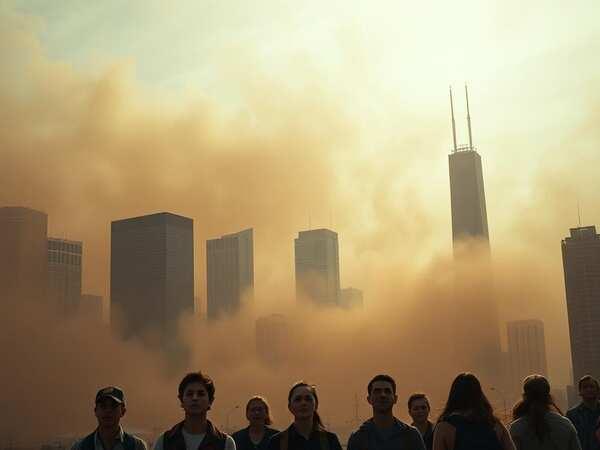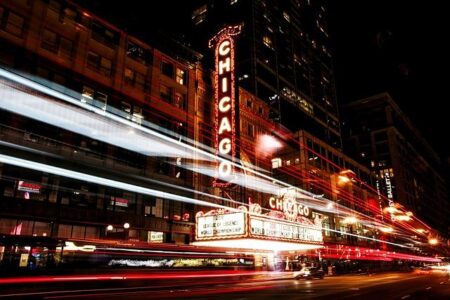Chicago Faces Unprecedented Dust Storm, Altering City’s Atmosphere
On a surprisingly blustery afternoon, Chicago was overtaken by a vast dust storm that dramatically altered the city’s usual skyline, casting an eerie amber veil over streets and skyscrapers. Residents and commuters alike described the event as surreal, evoking imagery reminiscent of historic dust storms from decades past. Within moments, visibility dropped sharply as a dense cloud of fine dust particles swept through downtown, leaving a gritty coating on cars, buildings, and sidewalks. Emergency services quickly mobilized to manage traffic disruptions and safeguard public health amid plummeting air quality.
Health officials promptly issued warnings advising sensitive populations-such as children, the elderly, and those with respiratory conditions-to limit outdoor exposure due to hazardous particulate levels. The sudden gusts,fueled by unusual atmospheric dynamics,caught many off guard. Below is a concise overview of the dust storm’s critical details:
| Parameter | Measurement |
|---|---|
| Peak Wind Speed | 45 mph (72 km/h) |
| Visibility Range | Under 200 feet |
| Storm Duration | Approximately 45 minutes |
| Air Quality Index (AQI) | Hazardous (300+) |
Social media platforms were inundated with striking photos and videos capturing the city enveloped in an orange-brown haze. Many users expressed a blend of interest and unease, sparking conversations about the rising occurrence of extreme weather events linked to climate variability.
- Transportation disruptions: Multiple highways and city streets were temporarily closed due to severely limited visibility.
- Health impact: Local hospitals reported a surge in patients experiencing respiratory distress.
- Cleanup efforts: City crews were deployed immediately to remove dust deposits and restore normalcy.
Personal Narratives Reveal the Storm’s Intensity and Historical Echoes
Chicagoans recounted vivid impressions of the dust storm’s arrival, describing a twilight-like gloom that swallowed the cityscape. One witness shared, “The sky turned a deep amber, and the air felt thick and heavy, almost like walking through a sepia photograph.” Others noted the unsettling quiet, broken only by the fierce wind’s howl-a stark reminder of nature’s overwhelming force.
The event’s historical importance resonated deeply with many, drawing parallels to the infamous Dust Bowl storms of the 1930s that devastated the American heartland. Community reflections included:
- Intergenerational memories: Elderly residents recalled family stories about similar dust storms from earlier eras.
- Environmental awareness: Both experts and citizens expressed concern over climate change intensifying such extreme weather phenomena.
- Cultural impact: The dramatic visuals reignited interest in historical archives and documentaries about past environmental crises.
| Witness | Account |
|---|---|
| Liam T., Hyde Park | “It was like stepping into an old sepia-toned film-both beautiful and unsettling.” |
| Maya S., River North | “The city felt frozen in time, reminding me of stories my grandmother told about the Dust Bowl.” |
| Carlos D., South Loop | “The storm’s force was palpable-an awe-inspiring yet humbling experience.” |
Scientific Analysis of the Sudden Dust Storm’s Origins
Meteorologists attribute the unexpected dust storm to a combination of rare atmospheric and environmental conditions. A prolonged dry period, coupled with strong winds sweeping in from the arid western plains, created the perfect scenario for dust to be lifted and transported over vast distances. Experts emphasize that this event underscores the complex interactions between weather systems, land surface conditions, and atmospheric instability. The absence of recent precipitation left the soil loose and vulnerable to wind erosion,intensifying the storm’s severity.
Primary factors identified include:
- Extended drought reducing soil moisture and cohesion
- Powerful westerly winds exceeding typical speeds
- Unstable atmospheric layers facilitating vertical dust uplift
- Limited vegetation cover failing to anchor soil particles
The table below compares key meteorological data recorded during the event against seasonal norms:
| Metric | Recorded Value | Seasonal Average |
|---|---|---|
| Wind Speed (mph) | 45 | 18 |
| Soil Moisture (%) | 12 | 35 |
| Relative Humidity (%) | 20 | 55 |
Essential Safety Recommendations for Residents During Dust Storms
When dust storms approach, it is vital for residents to seek immediate shelter indoors, ensuring all windows and doors are tightly sealed to prevent dust infiltration. Maintaining an emergency kit stocked with essentials such as bottled water, high-filtration masks (N95 or better), and battery-operated air purifiers can considerably reduce health risks. Individuals with asthma or other respiratory conditions should avoid outdoor exposure during and after the storm to minimize complications. If travel is unavoidable, keep vehicle windows closed, activate the recirculation air setting, and drive cautiously due to drastically reduced visibility.
Key precautions to observe during dust storms include:
- Monitoring local weather alerts through radio,apps,or emergency notifications.
- Wearing certified protective masks to filter out harmful dust particles.
- Limiting physical activity outdoors and turning off ventilation systems that draw in outside air.
- Keeping pets indoors and ensuring ample water supply for all household members.
- Preparing for potential power outages by having flashlights and extra batteries accessible.
| Safety Aspect | Recommended Action |
|---|---|
| Indoor Protection | Seal windows and doors; use air purifiers |
| Respiratory Safety | Wear N95 masks; avoid outdoor exposure |
| Driving Safety | Keep windows up; drive slowly with caution |
| Emergency Preparedness | Stockpile water, food, and emergency lighting |
Final Thoughts on Chicago’s Remarkable Dust Storm
As the dust gradually settled over Chicago, the city’s residents were left to contemplate an extraordinary natural event that seemed to echo the environmental challenges of the past. This rare dust storm, vividly documented and widely shared, serves as a powerful reminder of nature’s unpredictable might and the growing environmental pressures facing urban centers in the 21st century. CBS News remains committed to tracking developments related to this phenomenon and will continue providing updates on its aftermath and the measures undertaken to protect the community.





